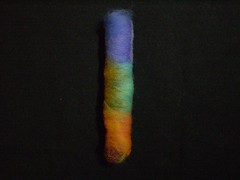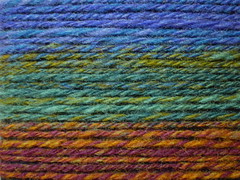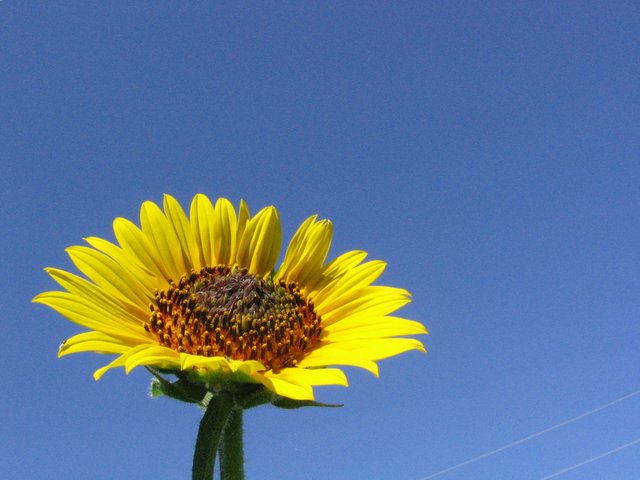
My dear friend, Allie Neas, one of the owners of Eye Dazzler Alpacas, gave me two ounces of sparkly alpaca roving "to play with." She and I met at a yarn shop (actually, as it happens, we crashed a birthday party and got invited to share in their lunch - it's all in the timing! Thanks Karen, for allowing us to share in your wonderful party-potluck! Visit Karen at her shop, Colorado Fiber Arts, and wish her a belated Happy Birthday!), and I spun some of it on my handspindle, and it was just too gorgeous for words. Oh, the sparkle! It brings out the magpie in me.
As usual, I spun this very fine and very tightly spun because, well, I have my flaws. So, I casually mentioned that I just bet that I could spin this lovely roving into something a little more... useable... if I only had use of a spinning wheel.... so Allie loaned hers to me for the weekend. Now, this was very clever of me, don't you think?
This is what came home with me  - an easier-to-use spinning wheel surely doesn't exist. I was able to set it up and get it running in no time at all. It's a Majacraft Suzie Pro Alpaca, and it's a wonderful machine! I just couldn't get over how easy and intuitive it was to set up and run. I especially like that it has a large, triangular opening for the yarn to pass through, rather than a little tube, like I've seen on other machines.
- an easier-to-use spinning wheel surely doesn't exist. I was able to set it up and get it running in no time at all. It's a Majacraft Suzie Pro Alpaca, and it's a wonderful machine! I just couldn't get over how easy and intuitive it was to set up and run. I especially like that it has a large, triangular opening for the yarn to pass through, rather than a little tube, like I've seen on other machines.
 - an easier-to-use spinning wheel surely doesn't exist. I was able to set it up and get it running in no time at all. It's a Majacraft Suzie Pro Alpaca, and it's a wonderful machine! I just couldn't get over how easy and intuitive it was to set up and run. I especially like that it has a large, triangular opening for the yarn to pass through, rather than a little tube, like I've seen on other machines.
- an easier-to-use spinning wheel surely doesn't exist. I was able to set it up and get it running in no time at all. It's a Majacraft Suzie Pro Alpaca, and it's a wonderful machine! I just couldn't get over how easy and intuitive it was to set up and run. I especially like that it has a large, triangular opening for the yarn to pass through, rather than a little tube, like I've seen on other machines. I spun a little while on a variety of alpacas in my stash - you can see my little pile there, in the lower left of the photo, then I sat down to spin the sparkley stuff. I spun all of the two ounces in just a few hours. This is amazing! I think that it came out very nice, with allowances for this being my first time on a wheel and all. I attempted to spin a thicker, soft, lofty yarn, and I like it!
Next, to prove that I did actually spin something useful, I sat down to knit some Mrs. Beeton's. The only problem is that I when I wanted to cast on, I was away from the house and away from my computer (Imagine that!) so I didn't have the pattern, so I came up with an approximation. Here's what I did - I worked a gauge swatch, and decided that 7 sets of k2p2 would make a nice size, so my "base number" is 28 stitches. I cast on three times this many, and knit stockinette for about one inch, then knit three together (slip 2 as if to knit, knit one, pass the two slipped stitches over) all the way around. Knit the cuff in k2p2 for approx 4.5 to 5 inches, or whatever length you like. Easy!
I finished these wristies in a nice little coffee shop on the Plaza in Taos. We returned from our trip a week ago, and until this morning, I hadn't seen my mitts, or my socks (future post) and I was beginning to think that I had left them at that nice little coffee shop on the Plaza in Taos! Oh, I was peeved with myself! However, as you can see, they returned (were in a child's room, aka "black hole"), and all is right in the world.
Anyway, back to the sparkly alpaca. This stuff spun just exactly like plain alpaca, which came as a complete surprise to me. I would have thought that the sparkle stuff was somehow stiff and non-compliant, and that it wouldn't stick to the fibers and draft out, but I was wrong. It drafted just fine, like it was alpaca fiber. This was nice. It was a very pleasurable spinning experience, watching the sparkle and feeling the alpaca, leave my hand and become yarn. I just love spinning!
Now, photographing it was another story. It's impossible to capture the sparkle! Very frustrating. However, I have a genius husband - I'm telling y'all - I'm surround, on all sides, by geniuses! He suggested that I underexpose the shot, and it works! Well, it works enough to demonstrate that sparkle is there - you have to *see* the sparkle with your own eyes in order to really appreciate it. Here is the skein, exposed as the camera wants to expose it.

Here is the skein, vastly underexposed. See? (make it bigger - you'll see it better)

Here is the skein, vastly underexposed. See? (make it bigger - you'll see it better)

So, like I said, I found the wristies just a few minutes ago, and asked my darling daughter to model them for me. It's very windy outside right now, so I thought that if we stood just inside the storm door, I'd have good light for the photo - (the "lump" on the uppermost wrist is G's wristwatch.) (Click the photo for a larger view) The dog got all excited because she KNOWS when photos are being taken and she wants to be in all photos, so here she is, wiggling and saying, "Pick me up pick me up pick me up."
The dog got all excited because she KNOWS when photos are being taken and she wants to be in all photos, so here she is, wiggling and saying, "Pick me up pick me up pick me up."

When Grace didn't pick her up, she simply-
leaped into Grace's arms, silly dog. (Grace is wearing her nice satin jacket for this photo shoot - and her pajama pants. You aren't supposed to know about the pajama pants, but I couldn't resist Dixie and her cuteness, so don't tell Grace, OK? Thanks.)
 The dog got all excited because she KNOWS when photos are being taken and she wants to be in all photos, so here she is, wiggling and saying, "Pick me up pick me up pick me up."
The dog got all excited because she KNOWS when photos are being taken and she wants to be in all photos, so here she is, wiggling and saying, "Pick me up pick me up pick me up."

leaped into Grace's arms, silly dog. (Grace is wearing her nice satin jacket for this photo shoot - and her pajama pants. You aren't supposed to know about the pajama pants, but I couldn't resist Dixie and her cuteness, so don't tell Grace, OK? Thanks.)

So, here is my photo shoot, with Dixie. Aren't they cute? Yes, I mean Grace, Dixie *and* the wristies!



Then, I thought about taking an underexposed photo in order to show off the shine, so I thought that maybe over by the piano would work. Take a look at what this sparkly alpaca does! What the Red Shoes does for your feet, the sparkly alpaca does for your hands! It makes you play the piano like a maniac!
Here is a shot of the rest of the ball of yarn, and the wristies.  There's plenty enough left to make another pair! So, one ounce would have easily completed this project. (in this photo, they don't look like they are the same size, I suddenly realized. They are just about the exact same size. I don't quite know why this photo came out so wonky.)
There's plenty enough left to make another pair! So, one ounce would have easily completed this project. (in this photo, they don't look like they are the same size, I suddenly realized. They are just about the exact same size. I don't quite know why this photo came out so wonky.)
 There's plenty enough left to make another pair! So, one ounce would have easily completed this project. (in this photo, they don't look like they are the same size, I suddenly realized. They are just about the exact same size. I don't quite know why this photo came out so wonky.)
There's plenty enough left to make another pair! So, one ounce would have easily completed this project. (in this photo, they don't look like they are the same size, I suddenly realized. They are just about the exact same size. I don't quite know why this photo came out so wonky.)Here is another feeble attempt at photographing the sparkle.  I'm telling you, this is the sparkiest yarn you could ever imagine, but you'll just have to believe me - I simply can't capture it in a photo.
I'm telling you, this is the sparkiest yarn you could ever imagine, but you'll just have to believe me - I simply can't capture it in a photo.
Oh, I almost forgot! While in Taos, we visited a number of gem and rock shops - my son is taking a jewelry-making class and needed some stones for setting, and I found and fell in love with "Goldstone," a man-made stone which is sparkly. After a while, it dawned on me - it looks just like this alpaca! Goldstone doesn't photograph any better than sparkly alpaca does. Also, my camera does weird things with red - these two are closer to the same color in real life, but the photo makes them look quite different. Anyway, both are sparkly and pretty and I like them.
Goldstone doesn't photograph any better than sparkly alpaca does. Also, my camera does weird things with red - these two are closer to the same color in real life, but the photo makes them look quite different. Anyway, both are sparkly and pretty and I like them.
If you want some sparkly alpaca roving of your very own, then please contact Allie at EyeDazzlerAlpacas, and she'll fix you right up.
Cheers!
Rosemary
;
;l
 I'm telling you, this is the sparkiest yarn you could ever imagine, but you'll just have to believe me - I simply can't capture it in a photo.
I'm telling you, this is the sparkiest yarn you could ever imagine, but you'll just have to believe me - I simply can't capture it in a photo.Oh, I almost forgot! While in Taos, we visited a number of gem and rock shops - my son is taking a jewelry-making class and needed some stones for setting, and I found and fell in love with "Goldstone," a man-made stone which is sparkly. After a while, it dawned on me - it looks just like this alpaca!
 Goldstone doesn't photograph any better than sparkly alpaca does. Also, my camera does weird things with red - these two are closer to the same color in real life, but the photo makes them look quite different. Anyway, both are sparkly and pretty and I like them.
Goldstone doesn't photograph any better than sparkly alpaca does. Also, my camera does weird things with red - these two are closer to the same color in real life, but the photo makes them look quite different. Anyway, both are sparkly and pretty and I like them.If you want some sparkly alpaca roving of your very own, then please contact Allie at EyeDazzlerAlpacas, and she'll fix you right up.
Cheers!
Rosemary
;
;l










































